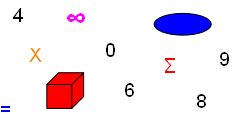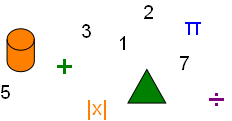



Cramer’s Rule for Solving a 3×3 System of Linear Equations


Cramer’s Rule easily generalizes to systems of n equations in n variables. The value of each variable is a quotient of two determinants. The denominator is the determinant of the coefficient matrix and the numerator is the determinant of the matrix formed by replacing the column of the variable being solved by the column representing the constants.
The solution for x2 in the system of linear equations:
a11x1 + a12x2 + a13x3 = b1
a21x1 + a22x2 + a23x3 = b2
a31x1 + a32x2 + a33x3 = b3
Is given by
x2 = |A2| / |A| =
Matrix A2
a11 | b1 | a13 |
a21 | b2 | a23 |
a31 | b3 | a33 |
÷
Matrix A
a11 | a12 | a13 |
a21 | a22 | a23 |
a31 | a32 | a33 |
Cramer’s Rule can now be stated; if a system of n linear equations in n variables has a coefficient matrix A with a nonzero determinant |A|, the solution of the system is:
x1 = |A1| / |A|,
x2 = |A2| / |A|,
… ,
xn = |An| / |A|
Where the ith column of Ai is the column of constants in the system of equations and the determinant, D, of the coefficient matrix is not zero.
Thus, to solve by Cramer’s Rule three linear equations having three variables:
Linear Equations System
2x + 4y − 3z = 1
5x − y + z = 6
y + z = 5
Cofactors of Determinant
D =
2+ | 4− | −3+ |
5− | −1+ | 1− |
0+ | 1− | 1+ |
=
2
−1 | 1 |
1 | 1 |
− 5
4 | −3 |
1 | 1 |
+ 0
4 | −3 |
−1 | 1 |
= 2 [−1(1) − 1(1)] − 5 [4(1) − 1(−3) + 0
= 2 (−2) − 5(7)
= −39
D ≠ 0; Cramer’s Rule applies …
Cofactors of Dx
Dx =
1+ | 4− | −3+ |
6− | −1+ | 1− |
5+ | 1− | 1+ |
=
1
−1 | 1 |
1 | 1 |
− 6
4 | −3 |
1 | 1 |
+ 5
4 | −3 |
−1 | 1 |
= 1 [−1(1) − 1(1)] − 6 [4(1) − 1(−3)] + 5 [4(1) − (−1)(−3)]
= 1(−2) − 6(7) + 5(1)
= −39
Cofactors of Dy
Dy =
2+ | 1− | −3+ |
5− | 6+ | 1− |
0+ | 5− | 1+ |
=
2
6 | 1 |
5 | 1 |
− 5
1 | −3 |
5 | 1 |
+ 0
1 | −3 |
6 | 1 |
= 2 [6(1) − 5(1)] − 5 [1(1) − 5(−3)] + 0
= 2(1) − 5(16)
= −78
Cofactors of Dz
Dz =
2+ | 4− | 1+ |
5− | −1+ | 6− |
0+ | 1− | 5+ |
=
2
−1 | 6 |
1 | 5 |
− 5
4 | 1 |
1 | 5 |
+ 0
4 | 1 |
−1 | 6 |
= 2 [−1(5) − 1(6)] − 5 [4(5) − 1(1) + 0
= 2(−11) − 5(19)
= −117
Then by Cramer’s Rule …
x = Dx / D = −39 / −39 = 1
y = Dy / D = −78 / −39 = 2
z = Dz / D = −117 / −39 = 3
The solution is (x = 1, y = 2, z = 3). This solution can be verified by replacing the x, y and z variables by their values in the original linear equations system.
You might have anticipated that 4×4 determinants can be defined in terms of 3×3 determinants, just as 3×3 determinants have been defined in terms of 2×2’s. Then 5×5 determinants can be defined in terms of 4×4’s, 6×6 in terms of 5×5’s and so forth. Cramer’s Rule can be extended to systems of four or more linear equations in the same number of variables.
Copyright © DigitMath.com
All Rights Reserved.